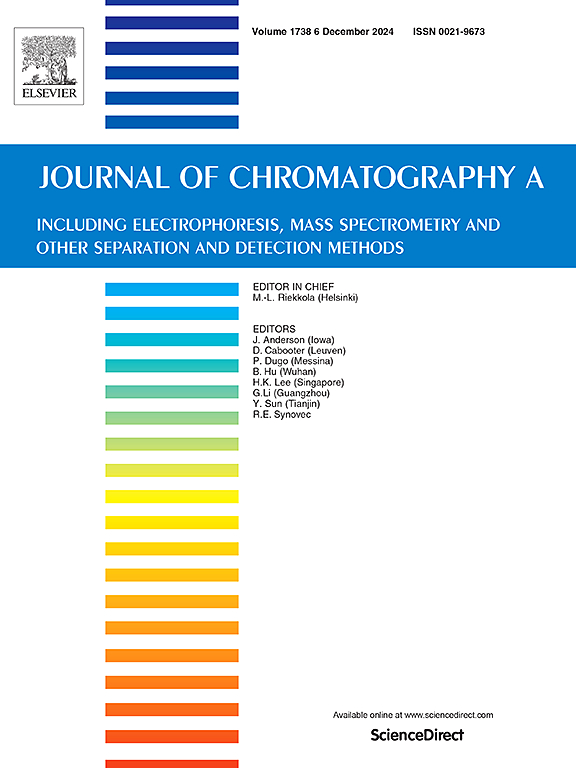利用液相色谱-串联质谱灵敏定量二羧酸的电荷反转方法
IF 3.8
2区 化学
Q1 BIOCHEMICAL RESEARCH METHODS
引用次数: 0
摘要
二羧酸(DCA)是中间代谢所必需的物质,与多种疾病相关的多个过程都有牵连。几种 DCAs 有助于能量代谢,影响线粒体功能,并在身体功能中发挥关键作用。然而,由于某些 DCAs 在各种体液中的丰度较低,因此对其进行定量分析尤其具有挑战性。因此,需要一种极其灵敏的方法来测定不同疾病生物样本中的 DCA 水平波动。我们开发并优化了一种 LC-MS/MS 方法来定量检测 DCA。在温和的碱性条件下,我们通过以羧基(R-COOH)为目标的二甲氨基苯乙酰溴(DmPABr)进行化学衍生,实现了化合物从负离子到正离子的电荷反转。衍生化提高了液相色谱-串联质谱定量分析的灵敏度、质量碎片和色谱分离度。该方法经过分析优化,对单个DCA具有极好的线性关系(R2>0.99),对所有DCA具有极低的检出限(LLOD<266 fg)和定量限(LLOQ<805 fg)。此外,大多数衍生化的 DCA 在室温下和经过十次反复冻融循环后都很稳定。经过提取和定量检测后,我们发现它们在血浆和尿液中的分布存在差异。DCA在血浆中的分布顺序为C4>C6>C7>C9>C5>C8>C22,而在尿样中的分布顺序为C4>C7>C6>C9>C5>C8>C10。对于长链(C> 16),血浆中的比例是尿液中的 10 倍。我们采用 LC-MS/MS 对方法进行了优化,能够以极佳的灵敏度对 DCAs 进行定量。该方法将有助于今后利用靶向代谢组学研究二羧酸在健康和生物标志物发现研究中的重要作用。本文章由计算机程序翻译,如有差异,请以英文原文为准。
A charge reversal approach for the sensitive quantification of dicarboxylic acids using Liquid chromatography-tandem mass spectrometry
Dicarboxylic acids (DCAs) are essential for intermediate metabolism and are implicated in multiple processes associated with various diseases. Several DCAs contribute to energy metabolism, impact mitochondrial function, and play a crucial role in body function. However, the low abundance of some DCAs in various body fluids makes their quantification particularly challenging. Therefore, an extremely sensitive method is required to determine DCA level fluctuations in biological samples in different diseases. We developed and optimized an LC-MS/MS method to quantify DCAs. We achieved charge reversal of the compounds from negative to positive ionization through chemical derivatization with dimethylaminophenacyl bromide (DmPABr) targeting the carboxyl group (R-COOH) under mild basic conditions. Derivatization enhanced sensitivity, mass fragmentation, and chromatographic separation for LC-tandem mass spectrometric quantification. The method was analytically optimized and demonstrated excellent linearity for individual DCAs (R2>0.99), as well as an exceptionally lower limit of detection (LLOD<266 fg) and lower limit of quantification (LLOQ<805 fg) for all DCAs. Furthermore, most derivatized DCAs were stable at room temperature and after ten repeated freeze−thaw cycles. After DCA extraction and quantification detection, we found differences in their distribution in plasma and urine. The rank order for DCAs in plasma is C4>C6>C7>C9>C5>C8>C22, whereas in the urine sample, the order is C4>C7>C6>C9>C5>C8>C10. For longer chains (C > 16), their proportions were >10x higher in plasma than in urine. Our optimized method using LC-MS/MS enables the quantification of DCAs with excellent sensitivity. The method will help in future studies investigating dicarboxylic acids' crucial role in health and biomarker discovery studies using targeted metabolomics.
求助全文
通过发布文献求助,成功后即可免费获取论文全文。
去求助
来源期刊

Journal of Chromatography A
化学-分析化学
CiteScore
7.90
自引率
14.60%
发文量
742
审稿时长
45 days
期刊介绍:
The Journal of Chromatography A provides a forum for the publication of original research and critical reviews on all aspects of fundamental and applied separation science. The scope of the journal includes chromatography and related techniques, electromigration techniques (e.g. electrophoresis, electrochromatography), hyphenated and other multi-dimensional techniques, sample preparation, and detection methods such as mass spectrometry. Contributions consist mainly of research papers dealing with the theory of separation methods, instrumental developments and analytical and preparative applications of general interest.
 求助内容:
求助内容: 应助结果提醒方式:
应助结果提醒方式:


